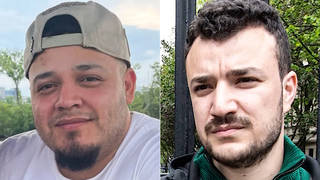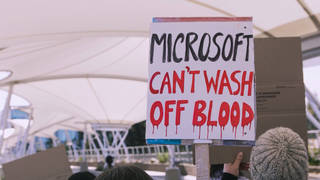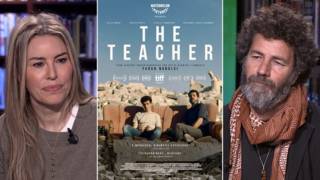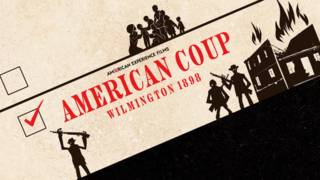
Guests
- Jacqueline Olivedirector of Always in Season, a documentary examining the history of lynchings in the United States.
As mass protests against racism and police brutality continue, at least five men — four Black and one Latinx — have been found hanging in public across the U.S. in recent weeks. We speak with Jacqueline Olive, director of “Always in Season,” a documentary that examines the history of lynchings through the story of Lennon Lacy, an African American teenager who was found hanged from a swing set in 2014. “They deserve a full investigation,” Olive says of the recent hangings, “and given the context of this history … that we look at them more than three days, and then that they are looked at as a whole.”
Transcript
AMY GOODMAN: This is Democracy Now!, democracynow.org, The Quarantine Report. I’m Amy Goodman. Amidst mass protests against racism and police brutality across the country, at least five men — four Black and one Latinx — have been found hanging in public across the United States in recent weeks. All five deaths were initially deemed suicides, but community advocates, scholars and those all too familiar with America’s racist history say there’s another possibility: lynching.
In Palmdale, California, authorities are investigating the death of 24-year-old Robert Fuller, a Black man who was found dead, hanged from a tree near the community’s City Hall earlier this month. City officials said he died by suicide, suggesting the cause was due to mental anguish related to the coronavirus pandemic. But Fuller’s loved ones believe he was lynched, and the community has been holding protests calling for justice. A week after Fuller was found hanged, Los Angeles County sheriff’s deputies shot and killed his brother, Terron Boone, in what authorities described as a shootout in a desert town near Palmdale.
Robert Fuller’s death came 10 days after another Black man, 38-year-old Malcolm Harsch, was found hanged from a tree about 50 miles away, in Victorville, California, May 31st. After calling for further investigation, Malcolm Harsch’s family said over the weekend that his death was in fact a suicide and that they had reviewed video footage the police provided. Community activists are still asking why it took so long for a thorough investigation into his death.
In New York, the New York Police Department is investigating the death of Dominique Alexander, a 27-year-old Black man who was found hanged in a Manhattan park two weeks ago. The local Medical Examiner’s Office ruled the cause of his death suicide.
And in Texas, Congressmember Sheila Jackson Lee of Houston is calling for an investigation after two recent hangings. Last week, police found a 17-year-old Black boy hanging from a tree in an elementary school playground in Spring, Texas. Earlier that week, a Latinx man was found hanged in Houston.
This all comes as a noose was found in the garage stall of Bubba Wallace, the only African American driver in NASCAR’s elite Cup Series. Wallace recently led a successful campaign to get NASCAR to ban displays of Confederate flags from its events.
Well, for more on this topic, we’re going to Durham, North Carolina, to speak with Jacqueline Olive, director of a film called Always in Season. It’s a devastating documentary that examines the history of lynchings in the United States through the story of Lennon Lacy, an African American teenager who was found hanged from a swing set in 2014. His mother, Claudia Lacy, believes he was lynched. Always in Season premiered at the Sundance Film Festival in 2019. Well, we’re going to go to Jacqueline in a minute, but first, this is the film’s trailer. A warning to our audience: This clip contains violent and racist imagery.
911 DISPATCHER: You said there’s a male suspect hanging from a swing?
CALLER: It’s a Black male subject.
UNIDENTIFIED: I think they hung him up to make it look like a suicide.
PIERRE LACY: It looked like a “back in the day” lynching.
DANNY GLOVER: His body would be hung in the courthouse square for all to see. All white folks are invited to the party.
SHERRILYN IFILL: Lynching was a message crime. They happened in places where the body would be seen. And it’s the public nature of lynching that really condemns the white community, because the idea that people didn’t know — they did know.
HEATHER RATTELADE: As I started researching Black males committing suicide in public over the last few years, I became quite concerned that there may be a bigger, surreptitious movement at play here.
REPORTER: The caption: “Last night pic before the game.”
CLAUDIA LACY: That does not sound like a person that was planning on killing himself.
AMY GOODMAN: That was the trailer for Always in Season.
Jacqueline Olive, we welcome you back to Democracy Now!, under horrible circumstances of one death after another, young African American men hanging from trees in the United States, not 100 or 200 years ago, but in these last weeks. Can you talk about the significance of this? Now, again, family members are not saying absolutely they know what happened in each case, as was the case in the particular hanging you looked at in Always in Season, but they are demanding answers and serious investigations. Can you start off with the Palmdale hanging in California?
JACQUELINE OLIVE: Absolutely. So, these hangings really come out of a climate in the White House in which there is intense vitriol and hatred that’s being messaged, and people are being energized and activated around those messages. You have militia groups that are activated in increasing numbers. You have increasing numbers of noose incidents, including the one that was found in Oakland, California, last week, incidents in which people are being threatened — Black people are being threatened with nooses.
And so, as this climate escalates and you have these hanging deaths that are incredibly alarming, then the first question that Black folks often have is whether or not there was lynching involved. And so, it is really important that when local officials come out to investigate these cases, that they frame their investigation and they frame their look at the evidence in this history, with historic lynchings, but also around the racial violence and division that’s going on currently.
AMY GOODMAN: So, you have Robert Fuller, who was found hanged outside of City Hall in Palmdale. And then you have Malcolm Harsch, like 60 miles away, found hung near the public library in Victorville.
JACQUELINE OLIVE: That’s right.
AMY GOODMAN: Now, the police departments in both these cases immediately closed the investigations and said that it was suicide. It took enormous pressure from activists in Victorville and the family to finally actually see video that the police had, that showed, in fact, Malcolm Harsch, it did look like he had taken his own life. That isn’t the case for Robert Fuller at this point. We don’t know what’s happened. And then you have these latest hangings of Black and Brown people: Wednesday, police found 17-year-old African American teen hanging from a tree, elementary school playground in Spring, Texas; on Monday, a Latinx man found hanged in Houston. And then one here in New York City. So, talk further about how people can know what police assume and what the history is.
JACQUELINE OLIVE: Sure. Well, typical of this case, and it was certainly the case with Lennon Lacy, that I researched really thoroughly as we filmed, is that the police generally show up, and they show up within three days or so, and they’ve made their conclusion of suicide. What they don’t take into account is this history or the family’s concerns deeply enough that there might have been a lynching and that their family member may have met violence.
And so, it was the case with Lennon Lacy, is that the police, within — his body was found on August 29th, 20 days after the uprising in Ferguson, Missouri, following the murder of Mike Brown — August 29, 2014, on a Friday. And the police station was closed over the weekend because there was a holiday, and so they didn’t come to investigate anything until Tuesday, when they approached Claudia, Lennon’s mother. And they didn’t look through his phone, and they didn’t look for evidence of anything beyond a suicide, but were really insistent that that was the case. And I found that this is happening again and again. And so, families are really calling for there to be a deeper investigation and for justice.
And you had mentioned that the family members of Malcolm Harsch have conceded that he committed suicide. One of the interesting things, as I was reading — two points that they made, one of which is that the police didn’t really investigate his case. Even though it was a suicide — it ended up being a suicide — it’s important that they show up and that they investigate it thoroughly, and they didn’t do that until there was press attention.
The other comment that was made around the case is that it’s a relief that that wasn’t a lynching. I think it’s equally as important that in these cases of suicide, that we look closely at that.
And so, in my research, as I was researching for Always in Season, I found that there were dozens of cases of Black people found hanging publicly since 2000 — since 1995, actually. I started looking at the case of Antwan Sedgwick, who was found hanging in Hampton, Virginia, hours after the O.J. Simpson verdict. And that case was ruled a suicide. And so, there have been dozens of deaths, and there, unfortunately, sadly, are not exact numbers. There’s a CDC report that I’ve been looking at that says that there have been 79 unsolved hangings of Blacks and that they’ve all been males, in this report, 79 hangings that are unsolved between 2000 and 2016.
And so, you have all of these cases in the midst of violence we know that’s not being acknowledged. If it weren’t for the outcry, the public outcry, around Ahmaud Arbery’s murder, for example, then the McDaniels, Travis and Gregory McDaniel, and the accomplice would not have been held accountable.
And so, there is a justified outcry. Even when the result is a suicide, there’s a justified outcry that comes out of the Black community, but by anyone who’s paying attention and concerned, that these might be lynchings.
AMY GOODMAN: I wanted to ask you about the case of “Tete” Gulley, a Black transgender woman experiencing homelessness who was found hanging in Portland, Oregon. It got a lot of attention recently, and, in fact, it got so much attention that a lot of people, including us, thought it had just happened in May of this year, but it was actually a year ago. The local medical examiner ruled her death to be a suicide, but her family believes she may have been killed. Now it’s getting renewed attention as a result of the hangings in California, Texas and New York have gained national attention. So, as you point out, it is not only Black men in these cases. And talk about the significance of the renewed interest in finding out what happened, investigating “Tete” Gulley’s death.
JACQUELINE OLIVE: Yeah. I think it’s important to look at. I also thought that the death happened on May 27th of this year, but, in fact, it was May 27, 2019. And part of that reason is because the case, the story, was dropped by the press in 2019 and then kicked up with these more recent hanging deaths. And so, this kind of invisibility that goes with these hanging cases, in general, is even greater with trans women, trans people, like “Tete” Gulley, for whom the family still believes that she didn’t commit suicide. And the last news reports I saw on the case were from 2019, until very recently.
And so, that’s just an example of how, when we look — one is, when we look at these cases individually, we’re not giving the issues the attention that’s merited, the issue about collectively what’s going on, beyond just dropping in on one case and then out when the police decide that they’ve figured out or that they’ve investigated enough, is that it’s important for journalists, in particular, to look at all of it comprehensively and in the context of historic lynching terrorism. And so, just as with historic lynchings, certainly Black men were the primary victims of lynching, but women and children were also the victims of lynching.
AMY GOODMAN: And can you talk about how these hangings are often after some kind of horrific event, like the police killing of Michael Brown in 2014? Lennon Lacy, the case you looked at, at Always in Season, that happened right after that. And then, of course, you have the killing of George Floyd in Minneapolis, the police uprising, and then these subsequent hangings.
JACQUELINE OLIVE: And they also come after touchstones that are racialized. And so, there was an upsurge in noose incidents, threats by noose, when President Obama campaigned for the very first time. Between 2005 and 2008, there was an upsurge that was reported by the Southern Poverty Law Center. And so, there are these points in which there is some momentum by the Black community, a bit of progress, that’s met with backlash. And there’s also these points in which there’s this signaling from leadership that violence is OK.
And so, you have, out of this, all of this violence that we see, and particularly Black people and Brown people are really tuned into, in ways that the mainstream doesn’t necessarily acknowledge. We see it. We understand that there are connections between what happens when police shoot Oscar Brown in the back, when they murder George Floyd on video, and these hangings, and that there could possibly be a connection. And so, the outcry, even when there’s a suicide, is out of this sense of urgency that all of these things, including the noose incidents and all of these ways that Black lives are threatened and minimized, they could very easily result in lynching.
AMY GOODMAN: You also have the case in 2018 of the son of a prominent Ferguson activist, Melissa McKinnies, her son found hanging behind the family home in Ferguson. He was 24 years old. She says he was lynched. So, in all of these cases, what are you demanding happens now, Jacqueline?
JACQUELINE OLIVE: I think that they deserve a full investigation, and that they — and given the context of this history and given what people in communities understand about the racial divisions in these communities and the families’ concern, that we look at them more than three days, that they are — and then that they are looked at as a whole, because whether or not these are lynchings or whether or not they’re suicides, is there — the question’s around: Is there this new trend for Black people to hang themselves publicly? There’s been historically the stigma for Black people about hanging, and certainly hanging publicly and hanging from trees. But if these are suicides, then that’s information that’s really important to understand, in addition to understanding what are the issues around structural racism that can increase depression and increase anxiety and the suicide rate for Black people. Those are all really important to understand.
So, you have, for example, Malcolm Harsch, who was found hanging, and even though the investigation hasn’t concluded yet because of toxicology reports, you have him found hanging at a homeless encampment. And so there are issues about housing instability and insecurity for Black people, in particular, that are important to look at.
AMY GOODMAN: Jacqueline Olive, I want to thank you for being with us. And again, thank you for your remarkable film, Always in Season —
JACQUELINE OLIVE: Thank you, Amy.
AMY GOODMAN: — a documentary about the history of lynchings in America. That does it for our show. I’m Amy Goodman. Thanks for joining us. Stay safe.












Media Options